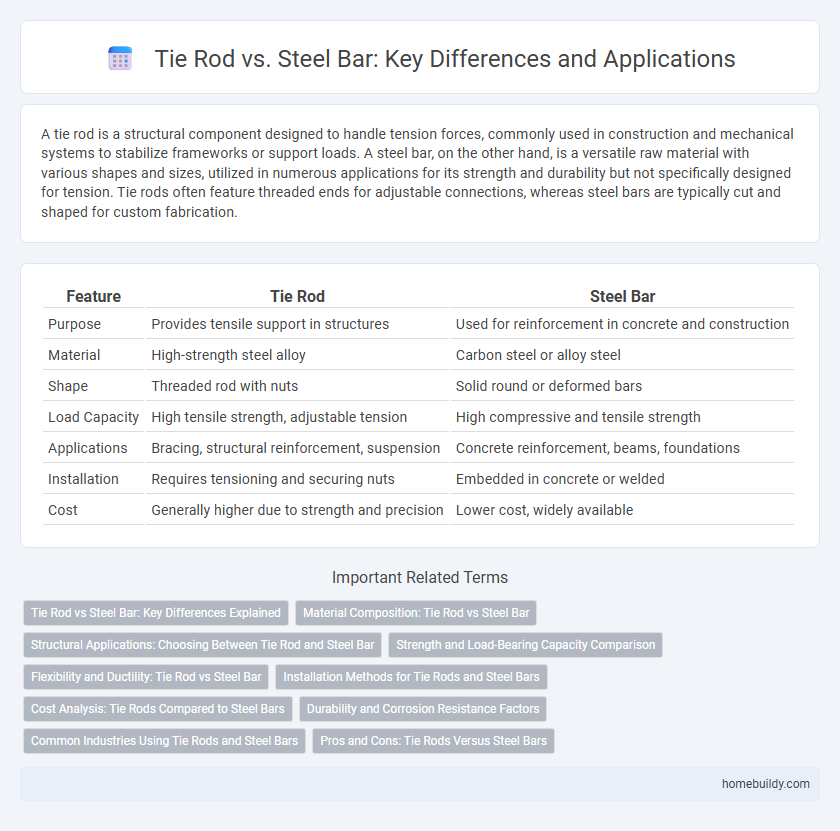A tie rod is a structural component designed to handle tension forces, commonly used in construction and mechanical systems to stabilize frameworks or support loads. A steel bar, on the other hand, is a versatile raw material with various shapes and sizes, utilized in numerous applications for its strength and durability but not specifically designed for tension. Tie rods often feature threaded ends for adjustable connections, whereas steel bars are typically cut and shaped for custom fabrication.
Table of Comparison
| Feature | Tie Rod | Steel Bar |
|---|---|---|
| Purpose | Provides tensile support in structures | Used for reinforcement in concrete and construction |
| Material | High-strength steel alloy | Carbon steel or alloy steel |
| Shape | Threaded rod with nuts | Solid round or deformed bars |
| Load Capacity | High tensile strength, adjustable tension | High compressive and tensile strength |
| Applications | Bracing, structural reinforcement, suspension | Concrete reinforcement, beams, foundations |
| Installation | Requires tensioning and securing nuts | Embedded in concrete or welded |
| Cost | Generally higher due to strength and precision | Lower cost, widely available |
Tie Rod vs Steel Bar: Key Differences Explained
Tie rods are engineered tension members designed for precise load-bearing applications, providing high tensile strength with minimal weight, whereas steel bars serve as versatile structural elements primarily used in compression and bending. Tie rods typically feature threaded ends for adjustable connections, enabling fine-tuning of structural tension, unlike solid steel bars which lack this adjustability. The specific design and installation of tie rods optimize structural performance in bridges, buildings, and machinery, contrasting with steel bars' broader use in reinforcing concrete and general fabrication.
Material Composition: Tie Rod vs Steel Bar
Tie rods are typically made from high-strength alloy steel with specific tensile and yield strength properties tailored for structural tension applications, whereas steel bars encompass a broader range of carbon steel grades used in general construction. The material composition of tie rods often includes elements like chromium and manganese to enhance durability and resistance to fatigue, contrasting with standard steel bars that may lack these alloying elements. This difference in material composition results in tie rods providing superior performance in load-bearing and long-span structural systems compared to conventional steel bars.
Structural Applications: Choosing Between Tie Rod and Steel Bar
Tie rods provide superior tensile strength and flexibility in structural applications, making them ideal for tension forces in bridges, roofs, and frameworks. Steel bars offer enhanced compressive strength and rigidity, often used in reinforced concrete and load-bearing columns. Selecting between tie rods and steel bars depends on the specific load requirements and structural demands of the project.
Strength and Load-Bearing Capacity Comparison
Tie rods exhibit superior tensile strength compared to standard steel bars due to their optimized cross-sectional design and high-grade materials, making them ideal for resisting tension in structural frameworks. The load-bearing capacity of tie rods is enhanced by their ability to effectively distribute stress along the length, reducing the risk of buckling common in solid steel bars under compression. In critical construction applications, tie rods provide a more reliable solution for maintaining structural integrity under dynamic and heavy loads, outperforming conventional steel bars in both strength and durability.
Flexibility and Ductility: Tie Rod vs Steel Bar
Tie rods exhibit superior flexibility compared to steel bars, allowing them to absorb and distribute dynamic loads more effectively in structural applications. Their higher ductility enables tie rods to undergo significant deformation before failure, enhancing safety by providing warning signs during overload conditions. Steel bars, while stronger in compression, are less flexible and ductile, making tie rods preferable for tension elements requiring resilience under varying stress.
Installation Methods for Tie Rods and Steel Bars
Tie rods are installed using threaded ends that allow precise tension adjustment through nuts, enabling easy alignment and secure fastening in structural applications. Steel bars typically require welding or bolting, which can be more labor-intensive and less adjustable after installation. The mechanical fastening of tie rods offers faster installation and maintenance advantages over the rigid fixation methods used for steel bars.
Cost Analysis: Tie Rods Compared to Steel Bars
Tie rods typically offer a more cost-effective solution compared to steel bars due to lower material and manufacturing expenses. While steel bars provide robust structural support, tie rods achieve similar tensile strength with less raw material, reducing overall project costs. This cost efficiency makes tie rods a preferable choice in construction and engineering applications where budget constraints and performance requirements intersect.
Durability and Corrosion Resistance Factors
Tie rods typically feature superior durability compared to standard steel bars due to their engineered tensile strength and heat-treated properties that resist deformation under stress. Corrosion resistance in tie rods is enhanced by protective coatings such as galvanization or stainless steel compositions, which outperform conventional steel bars prone to rust and surface degradation. These factors make tie rods a preferred choice in structural applications requiring longevity and minimal maintenance in harsh environmental conditions.
Common Industries Using Tie Rods and Steel Bars
Tie rods are extensively used in construction, automotive, and agricultural industries for structural support and tension control, while steel bars find applications in building frameworks, machinery manufacturing, and reinforcement in concrete structures. The construction sector prefers tie rods for adjustable tensioning systems, whereas steel bars are favored for their compressive strength and rigidity. Both components are essential in heavy machinery production and infrastructure projects, with specific selection depending on load requirements and flexibility.
Pros and Cons: Tie Rods Versus Steel Bars
Tie rods offer superior tensile strength and flexibility compared to steel bars, making them ideal for structural applications where tension adjustment is necessary. Steel bars provide greater compressive strength and rigidity but lack the ability to be easily tensioned or adjusted on-site. While tie rods enhance structural adaptability and ease of installation, steel bars deliver inherent durability and resistance to bending under heavy loads.
tie rod vs steel bar Infographic

 homebuildy.com
homebuildy.com